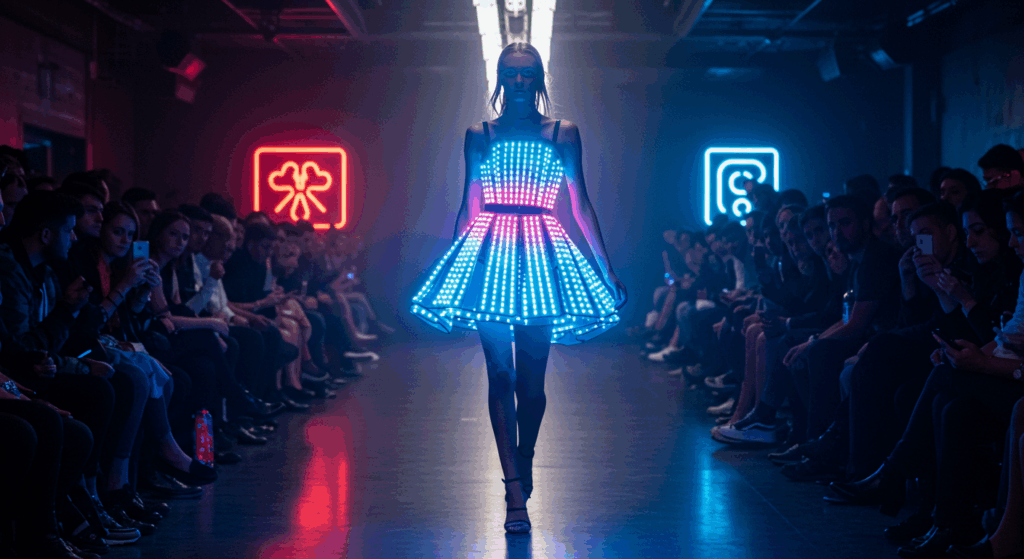What if your clothes could change color with your mood, regulate your body temperature, or even track your health? In 2025, the fashion industry is undergoing a radical transformation with the rise of smart fabrics, blending cutting-edge technology with style in ways we’ve never seen before. From LED-lit dresses on the runway to jackets that charge your phone, the future of fashion is here—and it’s more exciting than ever. At NovexaHub, we’re exploring this sartorial revolution in our moda category, diving into how smart fabrics are redefining style, sustainability, and self-expression in 2025 and beyond. Ready to step into the wardrobe of tomorrow?
Smart Fabrics Take Center Stage: Technology Meets Style

In 2025, smart fabrics are stealing the spotlight in the fashion world, turning clothing into interactive, multifunctional pieces. These textiles, embedded with sensors, microchips, and conductive threads, are designed to do much more than look good. At Paris Fashion Week 2025, designer Iris van Herpen unveiled a collection featuring dresses with embedded LED lights that shift colors based on the wearer’s heartbeat, creating a mesmerizing display of emotion-driven design. Meanwhile, brands like Adidas and Nike are rolling out jackets made with thermoregulatory fabrics that adapt to the weather—cooling you down in the heat and warming you up in the cold. Google’s Project Jacquard, which embeds touch-sensitive fibers into clothing, has partnered with Levi’s to release a denim jacket that lets you control your phone with a swipe on the sleeve. These innovations aren’t just gimmicks—they’re practical, stylish, and poised to become mainstream, with the smart textile market projected to reach $5 billion by the end of 2025. Fashion in 2025 isn’t just about what you wear—it’s about what your clothes can do for you.
Sustainability Meets Innovation: The Eco-Friendly Fashion Revolution

Smart fabrics aren’t just about tech—they’re also driving a sustainability revolution in 2025. With fast fashion under scrutiny for its environmental impact, brands are turning to technology to create eco-friendly alternatives. Companies like Bolt Threads are producing fabrics like Microsilk, a bioengineered material that mimics spider silk, offering durability without the environmental cost of traditional textiles. In 2025, H&M and Zara have launched collections made from recycled plastics woven with conductive fibers, creating garments that are both sustainable and tech-savvy. Smart fabrics are also reducing waste through customization: 3D knitting machines, paired with AI, allow brands to produce clothes on demand, minimizing overproduction. Designers are even experimenting with biodegradable smart fabrics that decompose naturally, leaving no trace behind. In a world increasingly aware of climate change, fashion in 2025 is proving that style and sustainability can go hand in hand, inspiring consumers to make greener choices without sacrificing flair.
Nostalgia Meets the Future: 90s Revival with a Tech Twist

While smart fabrics look to the future, fashion in 2025 is also taking a nostalgic turn, reviving the bold aesthetics of the 90s and early 2000s with a modern twist. Think chunky sneakers, metallic finishes, and low-rise jeans—now reimagined with technology. At Milan Fashion Week 2025, Versace showcased a line of metallic cargo pants with embedded LED strips that pulse to the beat of music, blending Y2K vibes with futuristic flair. Balenciaga’s latest collection features oversized hoodies with built-in health sensors that monitor heart rate and stress levels, merging 90s streetwear with wellness tech. Social media platforms like TikTok and Instagram are fueling this trend, with influencers donning “cyber-grunge” looks—think plaid skirts paired with smart glasses or bucket hats with holographic displays. In 2025, the past and future collide in fashion, creating a style that’s both nostalgic and forward-thinking, captivating Gen Z and Millennials alike.
The Wellness Wardrobe: Fashion That Cares for You

Fashion in 2025 isn’t just about looking good—it’s about feeling good, too. Smart fabrics are ushering in the era of the “wellness wardrobe,” where clothing actively supports your health and well-being. Brands like Lululemon are launching yoga pants with embedded sensors that track posture and provide real-time feedback via a connected app, helping you perfect your downward dog. Meanwhile, startup Wearable X has introduced Nadi X leggings, which vibrate to guide you through yoga poses, a technology that’s gained traction among fitness enthusiasts in 2025. Smart fabrics are also being used in medical applications: Sensoria’s socks, woven with pressure sensors, help diabetic patients monitor foot health, preventing ulcers. Even luxury brands are jumping on board—Chanel’s 2025 couture collection includes a silk scarf with embedded sensors that monitor air quality, alerting the wearer to pollutants. In 2025, your wardrobe isn’t just a fashion statement—it’s a partner in your wellness journey.
The Future of Style: What’s Next for Fashion?

As smart fabrics become more accessible, the future of fashion in 2025 and beyond looks limitless. By 2030, experts predict that most clothing will have some form of smart technology, from self-cleaning fabrics that use nanotechnology to garments that change shape to fit your body perfectly. AI-driven design tools are already allowing consumers to co-create their clothes—imagine designing a dress on your phone, with the fabric adapting its color and pattern in real time. The rise of the metaverse is also influencing fashion, with digital outfits made of smart fabrics being “worn” in virtual spaces, blurring the line between physical and digital style. But challenges remain: the high cost of smart textiles and concerns about data privacy (what happens to the health data your clothes collect?) need to be addressed. Fashion in 2025 is a thrilling glimpse into a future where style, technology, and sustainability converge. What do you think—would you wear a dress that changes color with your mood, or do you prefer classic style? Share your thoughts in the comments below, and explore more trends at NovexaHub’s moda category, where fashion meets the future.
